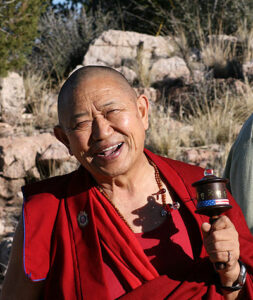The Process of Dying – Daily Practice of His Holiness the Dalai Lama
Translated and edited by Jeffrey Hopkins, Ph.D.
The process of dying involves a serial cessation, or dissolution, of the four internal elements: earth (the hard substances of the body); water (fluids); fire (heat); and wind (energy, movement). In ordinary life, these elements serve as the basis for consciousness, but during the process of dying, their capacity to support consciousness decreases, beginning with the earth element. Each step in this dissolution actually increases the capacity of the next element to support consciousness.
Step by step it looks like this:
- When the earth element, or hard substances of your body, dissolves into the water element, the external indication is that your body becomes thinner; internally, you see what appears to be a mirage seen in a desert.
- When the water element of your body dissolves into the fire element, the external signs are that the fluids in your body dry—your mouth dries, your nose puckers, and so forth; internally, you see what has been described as puffs of smoke from a chimney or smoke floating throughout a room.
- When the fire element of your body dissolves into the wind, or air, element, the external indication is that the heat in your body diminishes; internally, you see what look like fireflies at night or like scattering sparks. Heat withdraws from the body in different ways—from the feet upward to the heart or from the top of the head down. The former is preferable because it indicates that the mind will exit the body either upward or straight forward, not downward, and thus will most likely lead to a favorable next lifetime. This is caused by virtuous karma.
- Next, the wind, or movement of energy in your body, dissolves into consciousness, and your outer breath ceases; at this time you see an appearance like the light above a flickering candle flame when the fuel has almost been used up. (Some doctors would consider a person in this state to be dead, but from the Buddhist point of view the mere cessation of the outer breath does not mean that consciousness has left the body.) The flickering light is followed by the appearance of a steady flame. The final four phases of dying involve the dissolution of grosser levels of consciousness into subtler. This happens when the winds, or inner energies, that serve as the mounts of consciousness dissolve. Think of consciousness as mounted on energy like a rider on a horse. In preparation for the next phase, the energies that served as the mounts of the many types of conceptual consciousnesses dissolve, shifting the basis of consciousness from grosser to subtler levels of energy. These naturally occur in four phases:
- Your mind itself turns into an omnipresent, huge, vivid white vastness. It is described as a clear sky filled with moonlight—not the moon shining in empty space but that space filled with white light. Conceptual thought has vanished, and nothing appears except this vivid whiteness, which is your consciousness. However, a subtle sense of subject and object remains, so the state is slightly dualistic.
- Your mind turns into a red or orange vastness, more vivid than before; nothing else appears. It is like a clear sky filled with sunlight—not the sun shining in the sky but space itself, filled with red or orange light. In this state the mind is even less dualistic.
- Your mind itself turns into a still more subtle, vividly black state; nothing else appears. This is called “near-attainment” because you are close to manifesting the mind of clear light. The mind of black vastness is like a moonless, very dark sky just after dusk when no stars are seen. In the beginning of this phase you are aware, but then you lose awareness as you slip into even thicker darkness.
- When the mind of black appearance ceases, your mind itself turns into the fully aware mind of clear light. Called the fundamental innate mind of clear light, this is the most subtle, profound, and powerful level of consciousness. It is like the sky’s natural state at dawn (not sunrise)—without moonlight, sunlight, or darkness.
The passage through to the mind of clear light can be fast or slow. Some people remain in the final stage, the mind of clear light of death, for only several minutes; others stay for as long as a week or two. Since the mind of clear light is so powerful, it is valuable to practice, so many Tibetan practitioners rehearse these stages of dying on a daily basis.
I myself practice them six times daily by imagining the eight levels of mind one by one (without, of course, the physical changes in the first four stages). The eight levels of mind are:
- Mirage
- Smoke
- Fireflies
- Flame of a candle
- Vivid white sky-mind
- Vivid red or orange sky-mind
- Vivid black sky-mind
- Clear light
In the process of dying, we know that the person is still in the clear light as long as the body does not begin to smell or rot.
There are Tibetans who have been tortured and, upon being returned to their jail cells, sit cross-legged in the process of death, sustaining the mind of clear light. Reportedly, their Chinese Communist prison guards have been amazed by this. From the viewpoint of their own dogmatism, they regard Buddhism as blind faith, so when they are faced with such evidence, they try to keep quiet about it.
In India, too, quite a number of practitioners have remained in this state, sometimes for a few days and in one case for around seventeen days. When a person is abiding in the state of clear light, if the energy that supports this deep level of mind begins to fluctuate, at that point consciousness finally leaves the body, and the body or head shifts slightly.




